Question of the Month
September 2010
How does the 7D hold up in a real shoot?
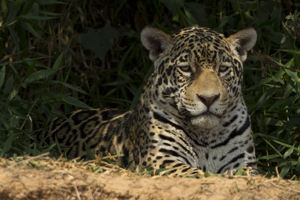
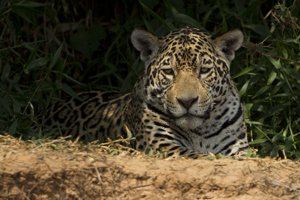
Can you tell which jaguar was made with which camera? One was shot with a 7D, the other with a Mark IV. Don't be fooled by image size - both are cropped!
Last month I compared the Mark IV with the Canon 7D, doing so based upon my initial impressions of comparing features, reading the manual and checking out tutorials, and having the camera in hand. But the real test is how a camera performs in the field, and for our one month long trip to Brazil I had a chance to really put the camera through its paces. By the way, we'll be offering only ONE Pantanal trip in 2011 because of our busy travel schedule, but in 2012 we are planning on three Pantanal trips, and extensions for the Maned Wolves and Monkeys, and probably somewhere else, too. Our 2011 brochure is not posted, but you can get a great idea of what we'll be offering by reading our 2010 Brochure. There will be some changes, but they will be minor. More importantly, these trips are extremely popular, so if you are even remotely interested in 2011 or 2012, contact our office, indicate the year, and you'll be on our first-contact list before we advertise the trips on our web site. No one offers a more complete and successful trip to this area for serious photographers, guaranteed! Ok, so you have fair warning, let's get back to the field test!
The first week of the trip, when we visited Northeastern Brazil to photograph Maned Wolves, flocks of Hyacinth Macaws, Marmosets, and the incredible, tool-using Capuchin Monkeys, dubbed 'Einstein Monkeys' I used the 7D as my primary camera. During our first Pantanal trip for jaguars both Mary and I used the camera extensively. By the third trip, we evolved a slightly different system which I'll go into shortly.
The camera performed well, although there were a few issues we had to adapt to. Foremost of these, we agree, is that the Spot Metering is linked to the center area, and not linked to whatever active focusing point we're using. On several occasions we erred on our Manual Exposures because we incorrectly thought we were metering on an outer focusing point, and not where the center point was actually positioned. With our Mark IIIs and IVs the metering is linked with the focus point, and we had to remember which camera we were using to prevent that error from recurring.
The 19 AF points were not a great imposition over our Mark cameras with 45 points. I do enjoy the broader choice of the 45 points, and, in fact, I actually reset my CF functions of my Mark IV to have all 45 points selectable, rather than 11 or 19, so that I could fine-tune exactly where I wanted my AF sensor to be placed. With only 19 points, our AF selection points were compromised, but not badly.
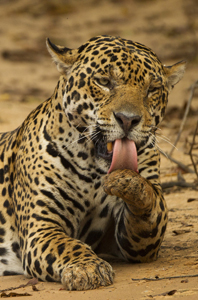 One of the more annoying traits of the 7D, and probably other Canon cameras of that class, is the operating mode wheel where one can select Manual, AV, Tv, or other modes.This can move accidentally. Our various trip participants had complained about this, so seeing this happen to us wasn't unexpected, but it was annoying when I'd go to meter and discover I was on Bulb or AV. In fact, on one occasion when I was on AV I was shooting a flying White-necked Heron and the exposures were all over the place. As I looked at the images on the LCD screen I saw that I had over-exposed herons, good herons, and underexposed herons. My first thought -- what the heck was I doing? Then I saw that I was on AV and, looking at the images again, I noticed that the backgrounds differed. For the overexposed heron, the bird was framed against a dark forest background,; for the good exposure, the bird was against blue sky, and for the underexposure, the bird was against a bright background -- all in the sweep of a 90 degree arc as the bird flew across the river.
One of the more annoying traits of the 7D, and probably other Canon cameras of that class, is the operating mode wheel where one can select Manual, AV, Tv, or other modes.This can move accidentally. Our various trip participants had complained about this, so seeing this happen to us wasn't unexpected, but it was annoying when I'd go to meter and discover I was on Bulb or AV. In fact, on one occasion when I was on AV I was shooting a flying White-necked Heron and the exposures were all over the place. As I looked at the images on the LCD screen I saw that I had over-exposed herons, good herons, and underexposed herons. My first thought -- what the heck was I doing? Then I saw that I was on AV and, looking at the images again, I noticed that the backgrounds differed. For the overexposed heron, the bird was framed against a dark forest background,; for the good exposure, the bird was against blue sky, and for the underexposure, the bird was against a bright background -- all in the sweep of a 90 degree arc as the bird flew across the river.
What that illustrated is how fallible any of the Priority Modes (AV, Tv, etc.) compared to Manual Mode. I showed one of our participants the sequence, as she had had exposures that were erratic, and I explained why that was happening. However, the middle of the Inquiries River is not the place to teach Manual Metering, but this exposure dilemma illustrates how important our Digital Complete Nature Photo Course is for understanding and then obtaining great exposures.
To be fair, the wheel shift didn't happen often so I didn't blow too many shooting opportunities because of it, but had I felt that I could gaffer tape the wheel so that it would not rotate, and do so without impacting upon the built-in pop up flash operation, I probably would have done so.
AF worked well, but to be honest I had a lot of difficulty getting sharp shots of birds flying at me with either Canon camera. It is my impression -- not a quantified analysis, however, that the Mark IV did a little better job at this, but our challenging subjects were Black-collared Hawks swooping in for tossed fish, and these birds literally rocket towards the water. However, I was disappointed with my 'keeper' rate for other flying birds as well, as the shots were close to critically sharp, and looked great on the camera's LCD monitor, but were not razor-sharp in many cases. That said, we did get plenty of very sharp images, especially when the bird was flying parallel to us.
I experimented with all the AF tracking modes, and although I had high hopes for the auto AF select choice for flying birds, I ended up using the center AF spot, and tracking as best I could myself, for my greatest success. To conclude, the AF system was no better than the Mark series, and perhaps a bit less, although this could be operator error on my part, and not the camera. I'm sure Canon would tell me that!
I actually loved the slightly slower high speed frame rate. With the Mark IV I believe that fps is 11, while it is 9 on the 7D. I often found that I literally ripped through the buffer on my Mark IV and would have to wait long, long seconds until the buffer finally cleared. This was because the Mark IV fired so fast, that in a few second action opportunity it was possible to indeed completely fill the buffer, sometimes even before the peak action was over. With the 7D's slightly slower fps rate that never happened, and I found that I never buffered out before the action was over. I really liked that.
While the megapixel count is higher on the 7D than the Mark IV, those pixels are different. At ISO 800, I felt that many empty areas -- like a blue sky -- had a grainy, noisy look that was not as evident with the Mark IV. In detailed areas that wasn't an issue. However, I could see a definite difference between images made with the Mark IV and the 7D. The IV, at least to my eye, had a smoother, finer look -- just a subtle quality difference that I felt I could detect. That said, it'd be interesting if I had someone else's images, shot with both cameras, either on my computer screen or as prints, I wonder if I could accurately guess which camera made which image. Honestly, I bet I could not, but looking at my own images I really felt I could see a difference. That said, when I knew I was going to need a higher ISO I'd try to use my Mark IV.
After about 10 days, Mary's 7D's pop-up flash stopped working, coming up with an error message when she tried to use it. Later on in the trip, that error message disappeared and the flash worked again! We can't explain why. I've always been a fan of these small pop up flashes for flash fill, and Mary actually used her's quite a llot to add flash fill on birds, even when she was using her 500mm lens. The only annoying aspect to this is that with that flash, you are limited to 1/250th sec shutter speed, so you cannot set High Speed Flash synch as you can when you are using a 580 flash. In the Pantanal, where we were often using fast shutter speeds, this shortfall was definitely a limitation.
I used the video feature with both the 7D and the Mark IV, and I think the shutter speed issue isn't as big a problem as it is with the Mark IV. Still, I find having to use the LCD screen for viewing to be very annoying, and the lack of AF is grating. Further, it seems (maybe operator error) that switching to video shifted focus a bit, so I found myself tweaking focus by zooming to 10X on the LCD screen. Regardless, though, I think the average user is deceived if you think video with these cameras is easy. The AF doesn't work, focus is tough, and the image, supported by a tripod designed for stills, can be jerky if any panning is involved. I question where I'll ever use any of the video I shot as well, aside from in Power Point presentations that may not work on someone else's computer. I addressed my video concerns in last month's question.
By our last trip I think both Mary and I independently evolved our own shooting systems using our Mark III's and IVs and 7Ds. Mary switched cameras frequently, putting the 7D on her 500mm when she needed added reach, although she usually had her 7D mounted to either her 70-200 f4 or 400 f5.6 lens. I settled for mounting my Mark IV on my 500mm, reasoning that I wanted the absolute fastest frame rate when there was action -- even though I sometimes buffered out! -- and I mounted my 7D on my 70 - 200 f4 for hand-held flight shots. Since the 7D has a 1.6X crop factor, I had the equivalent of a zoom reaching 320mm, so I felt I had plenty of reach, and flexibility for doing flight shots. In fact, too much lens sometimes proved disadvantageous. Once, when a Sunbittern (a bird with brilliant orange colored eyespots on its wings when in flight) flushed, I was 'greedy' and had my lens zoomed all the way to 200mm. Of course, when the bird took off I had too much lens and cut off parts of the bird -- nothing important, just the tips of its wings and head and neck! Had I zoomed back towards 70, I'd have had a good shot.
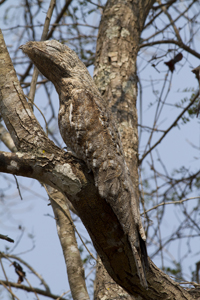
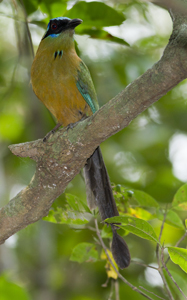
This Great Potoo and Blue-Crowned Mot-Mot were shot with a 7D and 400mm f5.6 combination. Carrying this light-weight rig was a joy, replacing my 500 and Mark IV which would have quadrupled the weight. The lighter weight is truly one of the major advantages of the 7D.
We bought the 7D primarily to save weight, and our bodies, and coupled with the light weigh 400mm f5.6 we sure did so.On one of our last days in the Pantanal, a biologist told us about a Greater Potoo, a nighthawk or whip-poor-will like bird that mimics a tree stump when perched, that was rooting about 1/2 mile away, about 3 meters off the ground. His directions seemed clear, so we decided to try to find it. As I lifted my 500mm, Mark IV, and Wimberley Gumbal Ballhead over my shoulder, I suddenly stopped and said to Mary, 'Let's use our heads. Let's use the 400s and 7Ds, and save a lot of weight. We did, and as we hiked out across the pastures leading to the forest both of us literally reveled in the reduction in weight. We found the Potoo, and got razor-sharp images of it, and of Nunbirds, Mot-Mots, and Creepers as we hiked through the forest. Of course, that 400mm f5.6 would be THE PERFECT LENS if it had IS, but tripod-mounted, it still is a darn near perfect one.
I found myself, during the trip, sometimes thinking, man, this 7D is the only camera I'll ever need. It's great. Now, as I look at the subtle differences in imagery between the Mark IV and 7D, especially at the higher ISOs, I still am a fan of the Mark IV, too. However, BOTTOM LINE, the 7D is a great camera. It is light weight, and it proved durable. I listed its short-comings above, and in the scheme of things those items are minor. I'd buy the camera again; we have no buyer's remorse, and, if I didn't have unlimited funds -- which I do not -- the camera, at about 1/3rd - 1/4th the price, is a great value. I love its light weight, and I found the video feature easier to use than with the Mark IV. If you're thinking of getting one, I'd say, Go ahead.'
Oh, by the way, to answer the question posed for the two jaguar shots, the image on the left, the larger jaguar, was shot with the 7D, and the other with the Mark IV. Although the small size of these images would make a judgment difficult, they are also indistinguishable after processing in the RAW converter. So, it really didn't matter for these two shots.
Previously, I posted my impressions of the Mark IV, which were very positive. I'm happy I own one, but as we thought about upgrading for Mary, and what we needed, we felt it was worth the gamble and try the 7D rather than more, and very much more expensive, Mark IV cameras.
If you are thinking of getting a new camera, I'd strongly recommend checking out the Canon DLC site and comparing the videos of the two cameras.
Questions of the Month
Which is the better camera, the Mark IV or the 7D?
Are there Mountain Lions (Pumas, Cougars) in Pennsylvania and the Mid-Atlantic States?
Why is bat photography so difficult?
What do I think of the Canon 1D Mark IV?
How do I deal with shaving weight for carrying my gear?
Why do I advocate manual exposure so avidly?
Where can I find Depth of Field reference charts?
What is the Kiboko backpack? Is it the New Best Pack?
Is there a correct position for the upright on a Wimberley actionhead?
How, Who, and Why? The story behind our new web site.
Archived Questions of the Month
Most of my original Questions of the Month for the last several
years are available through this link. The 'look' is from my
original web site, although if I ever have enough time I might
redo these pages to match the new web site But that's not
a high priority.


